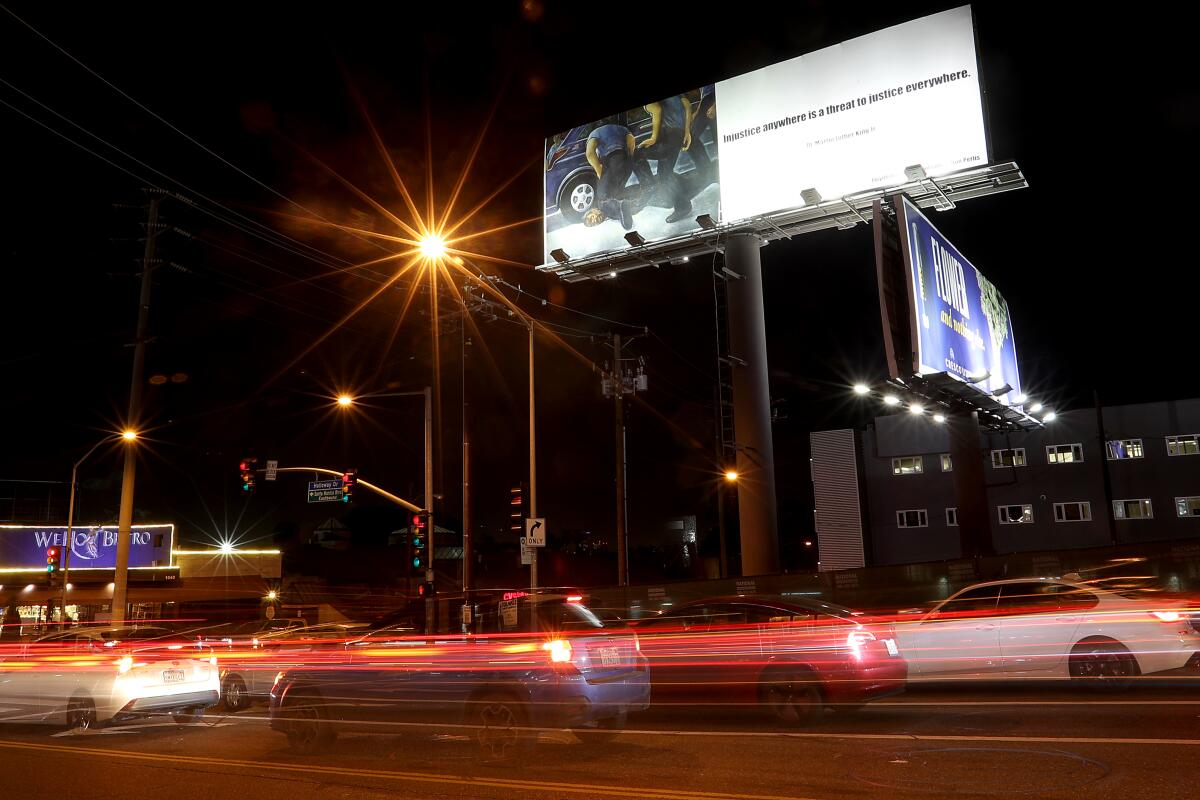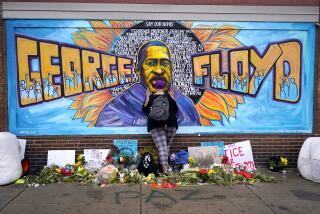George Floyd billboard, rejected elsewhere for ‘violence,’ rises in West Hollywood

In painter Don Perlis’ re-creation of the brutal killing of George Floyd, an officer kneels on Floyd’s neck and two other officers further pin him down, as another officer in the background looks away from the scene. Floyd’s eyes, frozen in anguish, gaze out toward the viewer.
The oil painting, alongside a quote from the Rev. Martin Luther King Jr. — “Injustice anywhere is a threat to justice everywhere” — is amplified on a 16-by-48-foot billboard at La Cienega Boulevard and Holloway Drive near the Sunset Strip in West Hollywood.
The billboard, which went up Monday, is from a group called the George Floyd Justice Billboard Committee. Its goal is to keep Floyd’s death front and center amid a seemingly never-ending news cycle, which most recently included a shockingly different police response to Trump supporters who violently broke into the nation’s Capitol. In late October, the group ran a similar billboard in New York’s Times Square with a quote from the Dalai Lama: “Be kind whenever possible. It is always possible.” The West Hollywood billboard will remain up for four weeks, and a replica is up in Atlanta.
“People need to remember how [Floyd] died and the same emotion people had then,” said committee chairwoman Corinne Basabe, who is an artist and TV producer. “People should be very concerned that justice is done.”
The group has struggled to put up a billboard in Minneapolis, the city where Floyd was killed, after two outdoor advertising firms, Clear Channel Outdoor and Outfront Media, refused to display the painting, saying it is too violent.
Perlis, who is based in New York, created “Floyd” soon after Floyd’s death last May. The 79-year-old artist has a history of painting social injustices, including the 1989 arrest and wrongful conviction of five Black and Latino teenagers in New York for the rape and beating of Trisha Meili, a white jogger in Central Park, and Michael Griffith, the Black man who died after being chased by a mob of white teenagers onto a busy highway in 1986.
Perlis took artistic liberties with the painting to emphasize the exact moment of Floyd’s death. “I changed the configuration of the figures, the location of the car,” he said. “I minimized the police in terms of guns and badges and things, because I wanted the painting to be on a human level.”
The message of the painting is simple: “men doing something bad to another man,” Perlis said.
Basabe first encountered Perlis’ “Floyd” painting in an exhibit in upstate New York. The committee needed a strong visual for the project, and most works Basabe had seen memorialized Floyd with portraiture.
Digital-art memorials to George Floyd, Breonna Taylor, Ahmaud Arbery and other black victims of white violence are rallying cries for social justice.
“Don’s image is important because it’s an image of what the policemen did to him, that brought people to the street, that evokes deep emotion, that makes people all over the world stand up and join with Americans in protesting,” she said.
In major cities, renting a billboard can cost more than $10,000 a month. The committee, made up of art professionals, reached out to potential donors and crowdfunded to cover costs.
As a white artist, Perlis worried there might be resistance to his depiction of Black death, “but that seems to not be an issue,” he said. Responses have been overwhelmingly positive, Basabe said. When one woman wrote the committee suggesting changing the Dalai Lama quote to one from King, the group agreed and made adjustments.
Instead, the struggles have come from interactions with the billboard companies.
To place a billboard in downtown Minneapolis in early January, Perlis reached out to national advertising firms Clear Channel Outdoor and Outfront Media, submitting the art along with coverage of the Times Square billboard. “They were all both very positive and excited,” Perlis said. “The committee chose the Clear Channel one because it was a more central location.”
Things seemed to be going well; Perlis signed a contract and paid for the billboard.
Then in early December a representative from Clear Channel asked if Perlis could swap out the image on the billboard and offered to refund the cost, $7,470. The account executive explained the order was canceled because the billboard image depicted violence. Clear Channel did not respond to The Times’ requests for comment.
After the cancellation, Perlis reached out again to Outfront Media to secure billboards in Minneapolis and L.A. Initially, Outfront processed the contract, but the order was abruptly canceled and the contract voided, Perlis said. Perlis said a representative from the company also implied in a phone call that the image was too violent. Outfront did not respond to The Times’ requests for comment.
“It’s not a violent image,” Perlis said. “There’s no knives, guns, blood.” He believes the decision was political. “A lot of people were against George Floyd, even after he got killed,” he added. “We thought it might be that, but we don’t know for sure.”
Basabe noted the resistance might be related to the upcoming March trial involving the four former officers charged with Floyd’s death.
When Outfront Media voided the contract for the Minneapolis order, it did the same for an L.A. billboard near the Sunset Strip.
Jason Swing, who runs the L.A.-based outdoor advertising firm Swing Media, helped to broker the contract with Outfront Media. When the deal fell through, Swing offered to rent one of his own billboards near the Sunset Strip, which had an unusual vacancy. Billboards in the area are usually booked long-term with major fashion brands and media companies including Netflix and HBO because of the prime location, Swing said.
“I don’t see anything wrong with it. I mean, I don’t think it’s even political,” Swing said. “It’s just a message from Martin Luther King reminding people of what happened.”
In the billboard world, art-related submissions are typically accepted, Swing explained.
“I just think billboard companies, they didn’t want to take the heat and deal with it,” he added. “And I’m shocked because billboard companies take all the PETA ads, and PETA ads are brutal.”
The George Floyd Justice Billboard Committee hasn’t given up on Minneapolis, and it’s in talks with other companies to secure another location. The goal, Basabe said, is to run billboards in more cities across the U.S. and internationally.
Perlis wants “to push this message of justice, humanity,” adding that he was happy to share the licensing permission for others to use the image on billboards. “We don’t want George Floyd’s death to go in vain, we don’t want it to be forgotten.”
Basabe hasn’t heard from the Floyd family about the campaign.
“I hope that they approve of what we’re doing,” she said, “because we definitely don’t want it to be forgotten, and we definitely want it to be taken the right way and respectfully.”
More to Read
The biggest entertainment stories
Get our big stories about Hollywood, film, television, music, arts, culture and more right in your inbox as soon as they publish.
You may occasionally receive promotional content from the Los Angeles Times.











